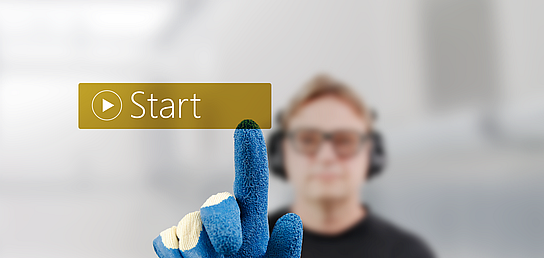Multitouch has become standard for many industrial HMIs. Smartphones and tablets have shown us the way. Nevertheless, there are some things to consider when you are designing a multitouch HMI. Below we have compiled the most important design recommendations for you.
Know The Used Touch Technology
There are countless different ways in which the touch is detected on the screen. Basically, the following techniques will be differentiated:
- Mechanical
- Optical
- Capacitive
- Acoustic
Each technique has advantages and disadvantages. The touch technology has an effect on the design of the HMI and it determines, whether multi-touch and gesture interaction is even possible. In industrial applications, however, the following touch techniques are used:
- Resistive Touch
- Projected Capacitive Touch (PCAP)
- Infrared Touch (IR)
Resistive Touch
With the resistive touchscreen, spacers (dots) separate two electrically conductive layers (foil – glass or glass – glass). By pressure on the upper layer, this touches the lower layer and provides for a changed electrical resistance, which is detected by the control unit.
PROS
- Inexpensive and established touch solution
- Can be operated with gloves and pens
- Safe from external triggering
- Suitable for outdoor use or in dirty environment
CONS
- Required (minimum) force for operation
- Not suitable for multitouch and gesture operation
- Touchscreen always needs a mounting frame
- Foil partially swallows the screen light (low-contrast and blurry screen impession)
Projected Capacitive Touch (PCAP)
With the capacitive touch, conductive paths (electrodes) are coated crosswise in the x and y directions on a protective glass in front of the screen. In this way, a capacitor is created at the crossing points. If a finger or a conductive object touches such a point, charge flows off at this point. The measured change of capacity indicates the touchpoint.
PROS
- Very suitable for multi-touch and gesture interaction
- Brilliant display of the screen content
- Protection against damage by protective glass
- Allows new form factor through frameless installation
- Established technology of the most smart devices
CONS
- Can’t be operated with gloves or only with thin gloves
- Requires special pen for pen operation
- Not suitable for outdoor usage or in humid environments
Infrared Touch (IR)
LEDs on the edge of the screen create a grid of infrared rays directly on the surface. Detectors on the sides of the display receive the emitted light again. The control unit detects if an object is blocking the light on its way to the detector.
PROS
- Suitable for multi-touch and gesture interaction
- Brilliant display of the screen content
- Allows operation with gloves
- Is mainly used for very large touchscreens
CONS
- Incident light can trigger touchscreen unintentionally
- Dirt or dust on infrared bar around screen may cause malfunction
- Touchscreen always needs a mounting frame
Recommendation: There is no way around the capacitive touchscreens if you want to implement an HMI with true multitouch and gesture interaction. Only this touch technology conveys the same user experience as the smart devices. In the meantime, such devices are available to the industry in large numbers and at reasonable prices.



